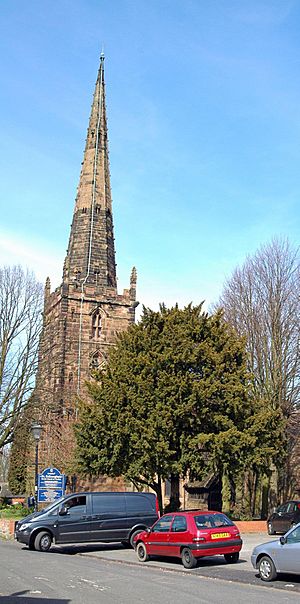St Edburgha's Church, Yardley facts for kids
Quick facts for kids St Edburgha's Church, Yardley |
|
|---|---|

St Edburgha's Church, Yardley
|
|
| 52°28′28″N 1°48′09″W / 52.4745°N 1.8026°W | |
| Denomination | Church of England |
| Churchmanship | Broad Church |
| Website | www.stedburghas.com |
| History | |
| Dedication | Edburga of Winchester |
| Administration | |
| Parish | Yardley, Birmingham |
| Diocese | Birmingham |
| Province | Canterbury |
St Edburgha's Church, also known as Old Yardley Church, is a special church in the Yardley area of Birmingham, England. It is a very old and important building, listed as Grade I, which means it is protected because of its history and beauty. It is also part of a protected area called the Old Yardley conservation area.
History of St Edburgha's Church
How Old is the Church?
This church is super old, dating back to the 13th century! That is over 700 years ago. It was built by Aston Church and was part of the Diocese of Lichfield. The church is named after Edburgha of Winchester, who was the granddaughter of King Alfred the Great.
Edburgha was a nun who lived her whole life in a place called St Mary's Abbey in Winchester. She was made a saint in 972. Some of her remains were moved to Pershore Abbey in Worcestershire. Yardley was part of the land given to this Abbey by King Edgar in 972.
Building the Church Over Time
Parts of the church, like the main hall (nave) and the side sections (aisles), were built in the 14th and 15th centuries. The tall church tower and its pointy top (spire) were added in 1461. However, the middle part of the spire was rebuilt in 1898 during a big repair project.
It is thought that the same skilled builder who made the spires at Sheldon and Kings Norton also built St Edburgha's spire. Inscriptions at Sheldon mention a builder named Henry Ulm and say the tower was built in 1461. This fits perfectly with the timeline for St Edburgha's Church. The church stands about 149 feet (45 meters) tall! For a long time, St Edburgha's was the only church in Yardley until another one, Marston Chapel, was built in 1704.
Roof Repairs and Services
The roof over the main part of the church was replaced between April and December 1926. During this time, church services were first held outside in the churchyard. But because of too many gnats, they had to move the services indoors to the parish hall instead.
Cool Features of the Church
Unique Doorway Carvings
One interesting thing to see is a doorway on the north side of the church. It has carvings of the Tudor rose and a pomegranate above the arch. These carvings were put there to celebrate the marriage of King Henry VIII's older brother, Prince Arthur, to Catherine of Aragon.
Mysterious Scratches
You might also notice some scraped marks at the bottom of the tower. No one knows exactly what caused them, but some people think they might be marks from people sharpening their tools a long, long time ago.
The Church Clock
The clock on the side of the church tower has been replaced many times. This is because the weather kept damaging it. The first clock was made of wood and often broke down. It also blocked a whole window on the tower! Now, the clock is made of metal, and you can see the window behind it.
Ancient Stone Slab
Inside the church, on a wall, there is a special stone slab made of alabaster. It has carvings of Thomas and Marion Est, who passed away in 1462. It is very old and worn, so the carvings are hard to see clearly.
Church Bells
How Many Bells?
Inside the church tower, there are eight bells! These bells were put in place in 1950. Before that, there were six older bells, which were melted down and reshaped, and two new smaller bells were added. They hang from a special frame made by a company called John Taylor & Co in Loughborough.
History of the Bells
Yardley had two bells even before 1638. It is believed that the metal from these very old bells was used to make three new bells in 1638. These were the oldest bells in the tower before the big changes in 1950. Another old bell was made in 1653 by John Martin of Worcester. A fifth bell was added by William Bagly in 1691, and the church had five bells for 200 years.
In 1892, the bells were rehung by Henry Bisseker. A sixth bell was added in 1902. This bell was made by James Barwell of Birmingham, who also made new parts for the bells to swing on. At the same time, the wooden frame inside the spire was fixed.
Bells Stop Ringing
In 1949, a problem was discovered: the church tower had death watch beetles! These tiny insects were damaging the wood, making it difficult to ring the bells. So, on May 1, 1949, the bells stopped ringing. This allowed workers to repair the frame and reshape the old bells. The new set of eight bells was officially blessed by Michael Parker, the Archdeacon of Aston, on September 9, 1950.
The Church Organ
The church used to have an organ made by the Aolian Company. It was repaired in 1955 and again later. That organ had 3 keyboards and pedals, with 34 different sounds. The organ you hear today was put in place in 1997 by Organ Tuning Services from Stratford-upon-Avon. You can find more details about this organ on the National Pipe Organ Register.
See also
- Listed buildings in Birmingham
Other Old Churches in Birmingham

